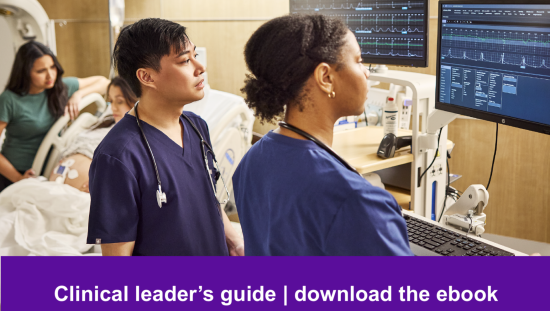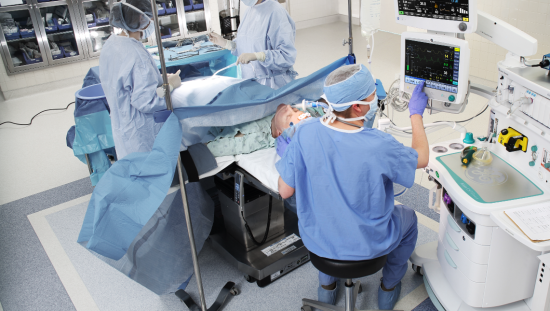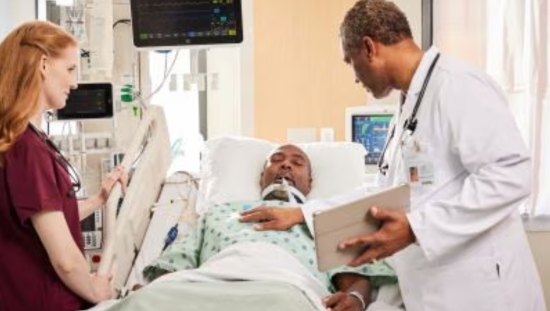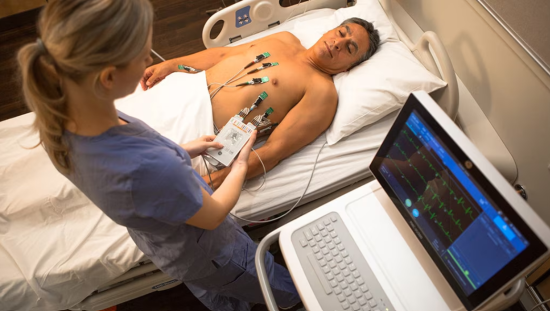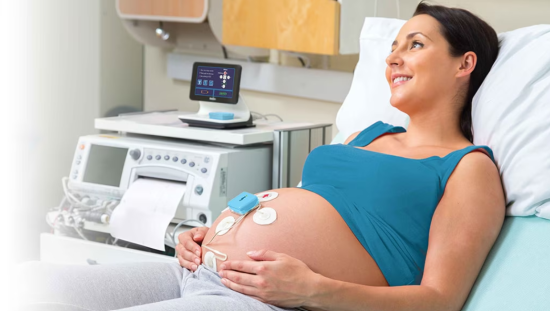Introduction
In a recent peer-reviewed study published in Anesthesiology,[1] Dr. Boris Mraovic* and colleagues at Missouri University Hospital present compelling evidence of the clinical impact of using End-Tidal Control** (EtC) software on GE HealthCare’s Aisys™ CS2 anesthesia machine. The study, titled Automated Volatile Anesthetics Delivery with End-tidal Control: Early Results from Adoption at Missouri University Hospital, highlights how EtC has significantly impacted the delivery of inhaled anesthetics.
Key Findings from the Study
The retrospective analysis evaluated 238 cases over a six-month period following EtC implementation. Among these, 49% utilized EtC while 51% were managed manually. The results were striking:
- Fresh Gas Flow Reduction: EtC cases averaged 1.1 L/min compared to 2.1 L/min in manual cases - a 45.6% reduction (P < 0.0001).
- Sevoflurane Consumption: Reduced by 45.6% in EtC cases (P < 0.0001).***
- Environmental Impact: Carbon dioxide-equivalent emissions per operating room decreased from 274.39 kgCO2e to 145.53 kgCO2e following EtC implementation. This reduction is roughly equivalent to saving 14.5 gallons of gasoline each month (P < 0.0001).
- Cost Savings: Monthly anesthetic costs per operating room dropped by 45.6% from $351.20 to $186.26 with EtC (P <0.0001).
- Utilization Trends: Only 7.2% of EtC cases exceeded 2 L/min fresh gas flow during maintenance, compared to 53.5% of manual cases (P <0.0001).
These findings underscore the potential clinical, economic, and environmental benefits of EtC and suggest that lower fresh gas flows with EtC’s automation may be achievable in routine U.S. practice.
Understanding Sustained Software Utilization
In clinical practice, the introduction of new software features often follows a familiar pattern: initial interest, brief utilization, and gradual decline in use. This pattern is well documented in the literature, with several contributing factors:
- Lack of Measurable Impact: Sustained use tends to diminish when a feature does not demonstrate clear clinical benefit.[2]
- Too Complex with Limited Advantage: Clinicians are less likely to integrate new technologies into long-term practice if they perceive them as complex and not meaningfully better than current approaches.[3]
- Leadership and Culture: Even well-designed technologies can struggle to gain traction if they don’t align with clinical priorities or lack visible support from leadership and a culture that embraces innovation.[4]
These common barriers–lack of measurable impact, perceived complexity, and limited leadership support–often prevent new technologies from achieving sustained use.
A Paradigm Shift in Practice
Dr. Boris Mraovic reflects on how these very factors were addressed during EtC’s adoption at Missouri University Hospital. He shares a practical analogy to illustrate how EtC overcame skepticism and reshaped clinical practice:
“All of the barriers to sustained use can be demonstrated in the context of EtC. First, some providers believe low-flow anesthesia is too complicated and could be unsafe, so they avoid using it. But, if you are open to new technologies, EtC makes low-flow anesthesia very easy. Once you begin using it regularly, you wonder whether it made any significant difference compared to what you have been doing for many years. That uncertainty can lead to a ‘why bother?’ moment.
Second, even when providers understand that EtC automatically adjusts FGF, end-tidal volatile anesthetic (VA) concentration, and inspired oxygen, they may still question its safety, thinking ‘Is EtC really safe? Does EtC do what it is promised? Especially when managing oxygen delivery - what if it fails?’ It is easy to press tabs on the anesthesia machine screen but understanding how EtC adjusts FGF and what triggers its safety algorithm can feel complex. After all, your first concern is the safety of your patients. EtC can reduce FGF to very low levels, even below 0.5 L/min, which can make clinicians uncomfortable, especially if they’ve accustomed to using higher flows.
Third, you may be environmentally conscious and want to reduce pollution and waste, and you understand that EtC can achieve these goals. However, if leadership is not aligned or willing to invest in the new technology, you would need significant effort to convince them. This could lead to frustration and/or giving up.
Traditionally, anesthesia has been compared to flying a plane. Taking off (induction/intubation) and landing (emergence/extubation) are the most dangerous phases of flying and delivering anesthesia. The rest of the flight (anesthesia maintenance) is assumed to be straightforward. But it is far from straightforward. It is more like asking a pilot to change direction, altitude and speed of the plane frequently.
EtC makes these “in-flight adjustments” replacing the manual actions of the clinician. You set your FGF, oxygen, and anesthetic target. EtC automatically adjusts–slowing down, speeding up, or stopping if needed (EtC changes FGF and VA concentration). For example, if oxygen delivery drops below safe levels, EtC alarms and switches to 100% oxygen and manual control. This automation reduces cognitive load and helps providers stay fresh and responsive during critical moments.
Using low/minimal flow anesthesia requires more vigilance, especially due to the risk of hypoxia where oxygen consumption could exceed oxygen delivery. For example, 50% FiO2 at FGF of 0.5 L/min delivers only 250 ml of oxygen per minute. Some patients’ oxygen requirements could require more, and over time, FGF would deliver FiO2 below 20%. EtC completely eliminates this risk by adjusting the delivered oxygen to achieve the set EtO2 concentration. Moreover, if EtC cannot achieve the set EtO2, it will alarm and switch to 100% and manual control.
Through off-loading manual tasks, EtC helps anesthesia providers stay focused and ready to respond during critical moments of the surgery, while still enabling safe low/minimal flows. This is especially helpful when anesthesia providers are focused on additional clinical tasks (e.g. placing lines, discussing with surgeon, checking patients under the drapes, charting, etc).
At the University of Missouri, we had champions who demonstrated EtC hands-on. Showing how EtC adjusted FGF and end-tidal VA concentrations gained providers’ interest. Demonstrating appropriate changes of inspired oxygen concentrations eliminated all concerns and acquired lifelong EtC users. “Seeing is believing.”
We addressed all three barriers mentioned above: we put effort in explaining and simplifying the complexity of how EtC works, provided feedback to anesthesia personnel, and had the support of leadership who understood all benefits of EtC. Indeed, this worked very well at MU and EtC usage was further improved in 1 year.
In summary, EtC fundamentally changes and simplifies the delivery of inhaled anesthetics. It reduces cognitive load, incorporates safety features, and supports environmental stewardship. These benefits are why I believe its utilization has been sustained. This is not just another software feature–it significantly changes and improves the way we care for our patients.”
Conclusion
The peer-reviewed study along with Dr. Mraovic’s insights offer compelling evidence that End-Tidal Control is more than a technical enhancement–it is a clinically relevant innovation that supports the evolving needs of anesthesia practice. The sustained adoption of EtC at Missouri University Hospital demonstrates how software, when thoughtfully designed and implemented, can drive measurable improvements in anesthetic delivery, resource utilization, and environmental impact.
EtC’s ability to empower clinicians to automate and optimize volatile anesthetic delivery positions it as a valuable tool for institutions seeking to advance perioperative care. As healthcare systems continue to prioritize sustainability, cost-efficiency, and patient-centered outcomes, EtC represents a clinically grounded solution that aligns with these goals. The findings from the study reinforce EtC’s relevance in real-world practices and highlights its potential to support broader adoption of low-flow anesthesia strategies.
References
[1] Mraovic, B, Cardonell, B, Johnson, Q, Luchetti, M, Beard, JW. Automated Volatile Anesthetics Delivery with End-tidal Control: Early Results from Adoption at Missouri University Hospital. Anesthesiology. 2025;143(2):464-467. doi:10.1097/ALN.0000000000005498
[2] Santos, W.J., Graham, I.D., Lalonde, M. et al. The effectiveness of champions in implementing innovations in health care: a systematic review. Implement Sci Commun 3, 80 (2022). https://doi.org/10.1186/s43058-022-00315-0
[3] Manish Putteeraj, Nandhini Bhungee, Jhoti Somanah, Numrata Moty, Assessing E-Health adoption readiness using diffusion of innovation theory and the role mediated by each adopter's category in a Mauritian context, International Health, Volume 14, Issue 3, May 2022, Pages 236–249, https://doi.org/10.1093/inthealth/ihab035
[4] Kosiol, J., Silvester, T., Cooper, H. et al. Revolutionising health and social care: innovative solutions for a brighter tomorrow – a systematic review of the literature. BMC Health Serv Res 24, 809 (2024). https://doi.org/10.1186/s12913-024-11099-5
* Dr. Boris Mraovic is a paid consultant for GE HealthCare. The statements by Dr. Mraovic here are based on his own opinions on results that were achieved in his unique setting. Since there is no “typical” hospital/clinical setting and many variables exist, i.e. hospital size, case mix, staff expertise, etc. there can be no guarantee that others will achieve the same results.
**Et Control is indicated for patients 18 years of age or older in the United States.
***Refer to the anesthetic agent labeling for information regarding indications for use, warnings, and other relevant clinical information specific to that anesthetic agent. For example, labeling for sevoflurane includes specific warnings related to the potential risk associated with use at a low flow rate and under certain clinical conditions. Any decisions regarding selection of anesthetic agent and flow rate should be made at the discretion of the clinician and in their medical judgment based on available information.
JB34811XX
©2025 GE HealthCare
GE is a trademark of General Electric Company used under trademark license. Aisys and Carestation are trademarks of GE HealthCare. Reproduction in any form is forbidden without prior written permission from GE HealthCare. Nothing in this material should be used to diagnose or treat any disease or condition. Readers must consult a healthcare professional.


